{% raw %}
Qyoto 中的小部件
在 Qyoto C# 编程教程的这一部分中,我们将介绍 Qyoto 小部件。
小部件是 GUI 应用的基本构建块。 多年来,几个小部件已成为所有 OS 平台上所有工具包中的标准。 例如,按钮,复选框或滚动条。 Qyoto 有一组丰富的小部件,可以满足大多数编程需求。 可以将更多专门的窗口小部件创建为自定义窗口小部件。
QCheckBox
QCheckBox是具有两种状态的窗口小部件:开和关。 接通状态通过复选标记显示。 它用来表示一些布尔属性。 QCheckBox小部件提供一个带有文本标签的复选框。
using System;using QtCore;using QtGui;/*** ZetCode Qyoto C# tutorial** This program uses QCheckBox* widget to show/hide the title* of the window.** @author Jan Bodnar* website zetcode.com* last modified October 2012*/public class QyotoApp : QWidget{public QyotoApp(){WindowTitle = "QCheckBox";SetupUI();Resize(250, 150);Move(300, 300);Show();}public void SetupUI(){QCheckBox cb = new QCheckBox("Show Title", this);cb.Checked = true;cb.Move(50, 50);cb.StateChanged += ShowTitle;}[Q_SLOT]public void ShowTitle(int state){if (state == (int) CheckState.Checked){WindowTitle = "QCheckBox";} else {WindowTitle = "";}}[STAThread]public static int Main(String[] args){new QApplication(args);new QyotoApp();return QApplication.Exec();}}
在我们的示例中,我们在窗口上放置了一个复选框。 复选框显示/隐藏窗口的标题。
WindowTitle = "QCheckBox";
在构建窗口期间,我们为窗口设置标题。
QCheckBox cb = new QCheckBox("Show Title", this);
QCheckBox小部件已创建。 构造器的第一个参数是其文本标签。 第二个参数是父窗口小部件。
cb.Checked = true;
标题在应用的开始处可见。 因此,也必须选中该复选框。 我们通过Checked属性选中该复选框。
cb.StateChanged += ShowTitle;
我们将ShowTitle()方法插入StateChange事件。 复选框的状态更改时,将发出事件。
[Q_SLOT]public void ShowTitle(int state){...}
方法定义之前带有Q_SLOT属性。 此属性通知编译器有关自定义槽的信息。
if (state == (int) CheckState.Checked){WindowTitle = "QCheckBox";} else {WindowTitle = "";}
根据复选框的状态,我们显示或隐藏窗口的标题。
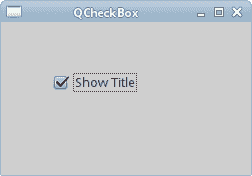
图:QCheckBox
QLabel
QLabel小部件用于显示文本或图像。 没有用户交互。
using System;using QtCore;using QtGui;/*** ZetCode Qyoto C# tutorial** This program uses QLabel to* show lyrics of a song.** @author Jan Bodnar* website zetcode.com* last modified October 2012*/public class QyotoApp : QWidget{public QyotoApp(){WindowTitle = "You know I'm no Good";InitUI();Resize(250, 150);Move(300, 300);Show();}public void InitUI(){string text = @"Meet you downstairs in the bar and heardyour rolled up sleeves and your skull t-shirtYou say why did you do it with him today?and sniff me out like I was Tanqueraycause you're my fella, my guyhand me your stella and flyby the time I'm out the dooryou tear men down like Roger MooreI cheated myselflike I knew I wouldI told ya, I was troubleyou know that I'm no good";QLabel label = new QLabel(text, this);label.Font = new QFont("Purisa", 9);QVBoxLayout vbox = new QVBoxLayout();vbox.AddWidget(label);Layout = vbox;}[STAThread]public static int Main(String[] args){new QApplication(args);new QyotoApp();return QApplication.Exec();}}
我们的示例在窗口中显示了歌曲的歌词。
string text = @"Meet you downstairs in the bar and heard...
我们定义了多行文字。 多行文本在 C# 语言中以@字符开头。
QLabel label = new QLabel(text, this);label.Font = new QFont("Purisa", 9);
我们创建标签小部件并更改其字体。
QVBoxLayout vbox = new QVBoxLayout();vbox.AddWidget(label);Layout = vbox;
代替手动编码标签的位置和大小,我们将标签放入盒子布局中。
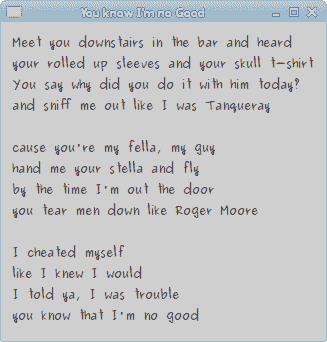
图:QLabel
QLineEdit
QLineEdit是一个小部件,允许输入和编辑单行纯文本。 QLineEdit小部件具有撤消/重做,剪切/粘贴和拖放功能。
using System;using QtCore;using QtGui;/*** ZetCode Qyoto C# tutorial** This program shows text* which is entered in a QLineEdit* widget in a QLabel widget.** @author Jan Bodnar* website zetcode.com* last modified October 2012*/public class QyotoApp : QWidget{QLabel label;public QyotoApp(){WindowTitle = "QLineEdit";InitUI();Resize(250, 150);Move(400, 300);Show();}public void InitUI(){label = new QLabel(this);QLineEdit edit = new QLineEdit(this);edit.TextChanged += OnChanged;edit.Move(60, 100);label.Move(60, 40);}[Q_SLOT]public void OnChanged(string text){label.Text = text;label.AdjustSize();}[STAThread]public static int Main(string[] args){new QApplication(args);new QyotoApp();return QApplication.Exec();}}
在我们的示例中,我们显示了两个小部件。 行编辑和标签小部件。 输入到行编辑中的文本显示在标签窗口小部件中。
QLineEdit edit = new QLineEdit(this);
QLineEdit小部件已创建。
edit.TextChanged += OnChanged;
当我们在行编辑中键入或删除某些文本时,将触发OnChanged()方法。 该方法采用字符串参数。
[Q_SLOT]public void OnChanged(string text){label.Text = text;label.AdjustSize();}
在OnChanged()方法中,我们将行编辑的内容设置为标签窗口小部件。 AdjustSize()方法确保所有文本都是可见的。
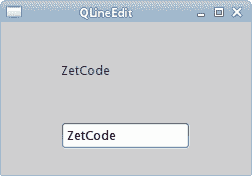
图:QLineEdit小部件
ToggleButton
切换按钮是设置了可检查标志的按钮。 切换按钮是具有两种状态的按钮。 已按下但未按下。 通过单击可以在这两种状态之间切换。 在某些情况下此功能非常合适。
using System;using QtCore;using QtGui;/*** ZetCode Qyoto C# tutorial** This program uses toggle buttons to* change the background colour of* a widget.** @author Jan Bodnar* website zetcode.com* last modified October 2012*/public class QyotoApp : QWidget{QWidget square;QColor col;QPushButton redb;QPushButton greenb;QPushButton blueb;public QyotoApp(){WindowTitle = "Toggle buttons";InitUI();Resize(350, 240);Move(400, 300);Show();}private void InitUI(){col = new QColor();redb = new QPushButton("Red", this);redb.Checkable = true;greenb = new QPushButton("Green", this);greenb.Checkable = true;blueb = new QPushButton("Blue", this);blueb.Checkable = true;redb.Toggled += OnToggled;greenb.Toggled += OnToggled;blueb.Toggled += OnToggled;square = new QWidget(this);square.StyleSheet = "QWidget { background-color: black }";redb.Move(30, 30);greenb.Move(30, 80);blueb.Move(30, 130);square.SetGeometry(150, 25, 150, 150);}[Q_SLOT]public void OnToggled(bool @checked){int red = col.Red;int green = col.Green;int blue = col.Blue;if (redb.Checked){red = 255;} else {red = 0;}if (greenb.Checked){green = 255;} else {green = 0;}if (blueb.Checked){blue = 255;} else {blue = 0;}col = new QColor(red, green, blue);string sheet = System.String.Format("QWidget {{ background-color: {0} }}",col.Name());square.StyleSheet = sheet;}[STAThread]public static int Main(string[] args){new QApplication(args);new QyotoApp();return QApplication.Exec();}}
在代码示例中,我们使用三个切换按钮来更改矩形小部件的颜色。
QWidget square;QColor color;QPushButton redb;QPushButton greenb;QPushButton blueb;
我们定义了五个对象。 方形小部件是QWidget,它显示颜色。 color变量用于保存颜色值。 这三个按钮是切换按钮,用于混合颜色值。
redb = new QPushButton("Red", this);redb.Checkable = true;
我们创建一个QPushButton小部件。 Checkable属性将按钮更改为切换按钮。
redb.Toggled += OnToggled;greenb.Toggled += OnToggled;blueb.Toggled += OnToggled;
所有三个按钮都插入到一个方法调用中,即OnToggled()方法。
square = new QWidget(this);square.StyleSheet = "QWidget { background-color: black }";
我们创建方形小部件。 一开始是黑色的。 在 Qyoto 中,我们使用样式表来自定义小部件的外观。
在OnToggled()方法内部,我们确定颜色值并将正方形小部件更新为新颜色。
int red = col.Red;int green = col.Green;int blue = col.Blue;
在这里,我们确定方形小部件的当前颜色。
if (redb.Checked){red = 255;} else {red = 0;}
根据红色切换按钮的状态,更改颜色的红色部分。
col = new QColor(red, green, blue);
我们创建一个新的颜色值。
string sheet = System.String.Format("QWidget {{ background-color: {0} }}",col.Name());
我们使用 C# Format方法创建适当的样式表。
square.StyleSheet = sheet;
正方形的颜色已更新。
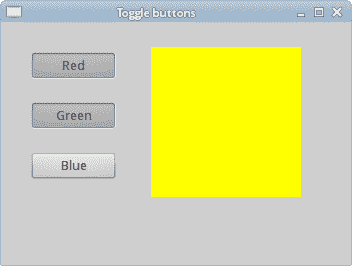
图:开关按钮
QComboBox
QComboBox是一个小部件,允许用户从选项列表中进行选择。 这是一个显示当前项目的选择小部件,可以弹出可选择项目的列表。 组合框可能是可编辑的。 它以占用最少屏幕空间的方式向用户显示选项列表。
using System;using QtCore;using QtGui;/*** ZetCode Qyoto C# tutorial** This program uses the QComboBox widget.* The option selected from the combo box is* displayed in the label widget.** @author Jan Bodnar* website zetcode.com* last modified October 2012*/public class QyotoApp : QWidget{QLabel label;public QyotoApp(){WindowTitle = "QComboBox";InitUI();Resize(250, 150);Move(300, 300);Show();}public void InitUI(){label = new QLabel("Ubuntu", this);QComboBox combo = new QComboBox(this);combo.AddItem("Ubuntu");combo.AddItem("Arch");combo.AddItem("Fedora");combo.AddItem("Red Hat");combo.AddItem("Gentoo");combo.Move(50, 30);label.Move(50, 100);combo.ActivatedString += OnActivated;}[Q_SLOT]public void OnActivated(string text){label.Text = text;label.AdjustSize();}[STAThread]public static int Main(String[] args){new QApplication(args);new QyotoApp();return QApplication.Exec();}}
在我们的代码示例中,我们有两个小部件。 组合框和标签小部件。 从组合框中选择的选项显示在标签中。
label = new QLabel("Ubuntu", this);
这是一个标签,它将显示组合框中当前选择的选项。
QComboBox combo = new QComboBox(this);
我们创建QComboBox小部件的实例。
combo.AddItem("Ubuntu");combo.AddItem("Arch");combo.AddItem("Fedora");combo.AddItem("Red Hat");combo.AddItem("Gentoo");
组合框将填充值。
combo.ActivatedString += OnActivated;
当我们从组合框中选择一个选项时,将触发OnActivated()方法。
[Q_SLOT]public void OnActivated(string text){label.Text = text;label.AdjustSize();}
在OnActivated()方法中,我们将标签小部件更新为从组合框中选择的当前字符串。
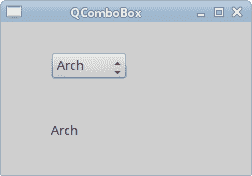
图:QComboBox小部件
在 Qyoto C# 教程的这一部分中,我们介绍了几个 Qyoto 小部件。
{% endraw %}

